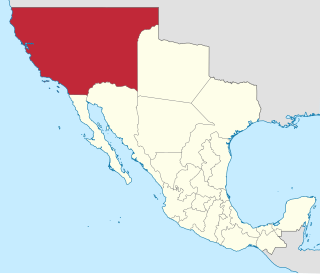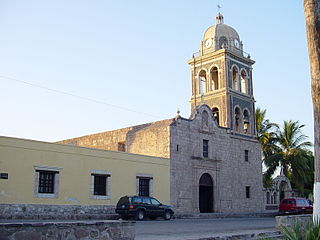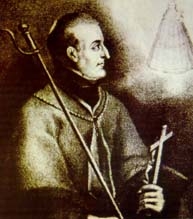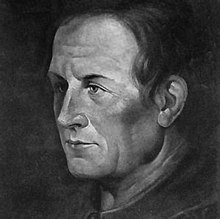
Alta California, also known as Nueva California among other names, was a province of New Spain formally established in 1804. Along with the Baja California peninsula, it had previously comprised the province of Las Californias, but was made a separate province in 1804. Following the Mexican War of Independence, it became a territory of Mexico in April 1822 and was renamed Alta California in 1824.

The suppression of the Society of Jesus was the removal of all members of the Jesuits from most of Western Europe and their respective colonies beginning in 1759 along with the abolition of the order by the Holy See in 1773; the papacy acceded to said anti-Jesuit demands without much resistance. The Jesuits were serially expelled from the Portuguese Empire (1759), France (1764), the Two Sicilies, Malta, Parma, the Spanish Empire (1767) and Austria, and Hungary (1782).

Francisco Hermenegildo Tomás GarcésO.F.M. was a Spanish Franciscan friar who served as a missionary and explorer in the colonial Viceroyalty of New Spain. He explored much of the southwestern region of North America, including present day Sonora and Baja California in Mexico, and the U.S. states of Arizona and California. He was killed along with his companion friars during an uprising by the Native American population, and they have been declared martyrs for the faith by the Catholic Church. The cause for his canonization was opened by the Church.

Beginning in the 16th century Spain established missions throughout New Spain in order to facilitate colonization of these lands.

Misión de Nuestra Señora de Loreto Conchó, or Mission Loreto, was founded on October 25, 1697, at the Monqui Native American (Indian) settlement of Conchó in the city of Loreto, Baja California Sur, Mexico. Established by the Catholic Church's Jesuit missionary Juan María de Salvatierra, Loreto was the first successful mission and Spanish town in Baja California.

Juan María de Salvatierra, S.J., was a Catholic missionary to the Americas.

Patrick William Riordan was a Canadian-born American prelate of the Catholic Church who served as Archbishop of San Francisco from 1884 until his death in 1914. He served during the 1906 San Francisco earthquake, and he was a prominent figure in the first case submitted to the Permanent Court of Arbitration.

The Archdiocese of Hermosillo is a Roman Catholic Archdiocese located in Hermosillo, Sonora, Mexico. Its area is 90,959 sq. miles, and its population (2004) 1,067,051. The bishop resides at Hermosillo.

José de Gálvez y Gallardo, 1st Marquess of Sonora was a Spanish lawyer and Visitador general in New Spain (1764–1772); later appointed to the Council of the Indies (1775–1787). He was one of the prime figures behind the Bourbon Reforms. He belonged to an important political family that included his brother Matías de Gálvez and nephew Bernardo de Gálvez.

The Spanish missions in Baja California were a large number of religious outposts established by Catholic religious orders, the Jesuits, the Franciscans and the Dominicans, between 1683 and 1834. The missionary goal was to spread the Christian doctrine among the Indigenous peoples living on the Baja California peninsula. The missions gave Spain a valuable toehold in the frontier land, and would also act as a deterrent to prevent pirates from using the peninsula of Las Californias as a jumping off point for contraband trade with mainland New Spain. Missionaries introduced European livestock, fruits, vegetables, and industry into the region. Indigenous peoples were severely impacted by the introduction of European diseases such as smallpox and measles; furthermore, the expulsion of the Jesuits from the Spanish Empire in 1767 ripped the social fabric of the peninsula, although Franciscans were sent to replace them. In 1769, the Franciscans moved to Upper California, leaving Dominicans in charge of Baja California. By 1800 indigenous numbers were a fraction of what they had been before the arrival of the Spanish, yet even today many people living in Baja California are of indigenous heritage.

Fernando Javier Rivera y Moncada was a soldier of the Spanish Empire who served in The Californias, the far north-western frontier of New Spain. He participated in several early overland explorations and later served as third Governor of The Californias, from 1774 to 1777.
Francisco Palóu , OFM (1723–1789) was a Spanish Franciscan missionary, administrator and historian on the Baja California Peninsula and in Alta California. Palóu made significant contributions to the Alta California and Baja California mission systems. Along with his mentor, Junípero Serra, Palóu worked to build numerous missions throughout Alta and Baja California, many structures of which still stand today. A member of the Franciscan Order, Palóu became "Presidente" of the missions in Baja California, and later of missions of Alta California. Palóu's work in the Spanish mission system spans from his early twenties to his death at the age of 66.

The Californias, occasionally known as the Three Californias or the Two Californias, are a region of North America spanning the United States and Mexico, consisting of the U.S. state of California and the Mexican states of Baja California and Baja California Sur. Historically, the term Californias was used to define the vast northwestern region of Spanish America, as the Province of the Californias, and later as a collective term for Alta California and the Baja California Peninsula.

Padre José González Rubio, O.F.M. was a Californio Roman Catholic friar, known best for his long tenure as Chief Administrator of Mission Santa Barbara, in Southern California.

Francisco García Diego y Moreno was a Spanish Catholic prelate who served as the first Bishop of the Californias.

The Spanish missions in the Americas were Catholic missions established by the Spanish Empire during the 16th to 19th centuries in the period of the Spanish colonization of the Americas. Many hundreds of missions, durable and ephemeral, created by numerous Catholic religious orders were scattered throughout the entirety of the Spanish colonies, which extended southward from the United States and Mexico to Argentina and Chile.

The Mexican Secularization Act of 1833, officially called the Decree for the Secularization of the Missions of California, was an act passed by the Congress of the Union of the First Mexican Republic which secularized the Californian missions. The act nationalized the missions, transferring their ownership from the Franciscan Order of the Catholic Church to the Mexican authorities.

The Province of Las Californias was a Spanish Empire province in the northwestern region of New Spain. Its territory consisted of the entire U.S. states of California, Nevada, and Utah, parts of Arizona, Wyoming, and Colorado, and the Mexican states of Baja California and Baja California Sur.
This is a list of lists of Spanish missions in the Americas. The Spanish colonial government coordinated with the Roman Catholic Church to establish churches throughout their New World possessions.

















